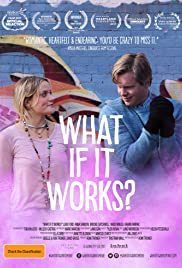
WHAT IF IT WORKS
Australia, 2017, 95 minutes, Colour.
Luke Ford, Anna Samson, Brooke Satchwell, Wade Briggs, Karen Fairfax.
Directed by Romi Trower.
There have been many films over the years, especially in recent years, about relationships, romantic relationships, potential healing relationships between people who are physically and/or mentally disabled. We don’t always expect to see these stories acted out in the ordinary streets, in the ordinary suburbs of Melbourne. They are acted out here – but, at the end, there is still the question that the title raises, will it work, what if it works?
It takes a few moments to get into the feel of the film We are introduced to Adrian, Ford, a young man in his 30s, driving a fast car, getting into trouble, landing unsuspectingly into a group of drag queens. Who is Adrian? When we see him behave, gloved hands, hands raised in the air, wary of touching anything, fastidious, we realise that he is absolutely obsessive, has a compulsive disorder. Which means that while he is friendly in his way, it is not always easy to like him. Non-compulsiveness will feel very impatient with him. But, as we get to know him, see him in all his foibles, there has to be some sympathy. In fact, he is very intelligent with science and engineering and is able to help people in the art commune, even calling in the aid of the drag queen friends.
He almost runs over a young woman (Anna Samson) who lives just up the street, who walks dogs (which he abhors). When he encounters her on his session with his therapist and she comes to visit, mistaking him for the therapist and pouring out a rather salacious life story, he is upset. He later meets her in the street.
It emerges that she has multiple personalities, explaining to him that she is rather like a block of flats with 10 particular rooms, some of the inhabitants being aware of the others, each able to emerge at various times. She has a reasonable personality, Grace. She has a very progressive personality G. She is also an artist, involved with a fellow artist who, in fact, is rather jealous of her art and exploitative of her as a person. She is unaware that she has an opportunity for an international exhibition, he concealing it from her.
A lot of the film is the interaction between Adrian and Grace, and how a relationship can develop between a fastidious untouching and untouchable man and a reticent woman who will erupt, often unexpectedly, with another self. There is a further complication that Adrian has had a relationship previously with a young woman who also is afflicted, by her self-image and self-doubt.
The film does not take us necessarily very far but invites its audience to contemplate these central characters, to reflect on how they are hampered by the disabilities, to wonder whether therapy will help, to wonder whether the relationship will enable some breakthroughs and some healing.
And at the end, we are left to wonder, of course, what if it works?
1. The title? The nature of “it�? The relationship between Adrian and Grace? Difficulties to be overcome? To make “it� work?
2. The Melbourne setting, the streets and houses, the garage, the art studio, therapy sessions? The ordinariness of Melbourne city life? With extraordinary characters? The musical score?
3. Themes of disability, physical, mental, OCD, autistic personalities? Multiple personalities? The manifestation of these disabilities in ordinary life, in the street? In therapy?
4. Luke Ford as Adrian, his age, background, with his parents, the influence of his father, living by himself, his studies and engineering expertise, work at the garage, the continued phone calls from Stan, wanting him back? His achievements at the garage?
5. Driving the car, the flat tire, the encounter with the drag queens – and later returning to visit them with Grace, and their joining in the video installation at the end? His love for cars, and driving cars?
6. His obsessive compulsive disorder, wearing the gloves, holding his hands high, avoiding touching anything except at home, the computer board? His understanding of his disorder? His visit to the therapist, the discussion, his manifestations, not wanting to continue?
7. The irony of the therapist going upstairs, Grace coming to visit, mistaking him for the therapist, the outpouring of her story? The different personalities, especially the aggressive G?
8. The encounters between Adrian and Grace, her walking the dogs, her apartment? The background of her artwork, the studio, the fellow artist and his deceiving her about the invitation from London? Sexual exploitation? The other members of the group, their creations, especially the man working on the installation?
9. Grace, the different personalities, explanation about the building with the 10 apartments, several of the personalities knowing each other? The different manifestations? In relationships, in the art work? Grace and the attraction to Adrian? The meetings, outings, walks? His recognising the different personalities?
10. The background of Adrian and his relationship with Melinda, the breakup, her own disabilities, emotional, self-image? Discussions with Adrian? The prospect of her engagement and marriage?
11. The personality of the therapist, the various meetings, the therapies?
12. Adrian, the confrontation with the fellow artist, overhearing the truth about Grace and her art? His revealing the truth to her? Grace and the conflict? Completion of her work? And the completion of the installation and the drag queens enjoying their performance?
13. Adrian, the effect of the friendship with Grace, still with his gloves, not wanting to be touched, Grace not wanting to touch him – then seeing them walking down the street, the possibility of hand in hand and what it might lead to?
14. What if it worked?